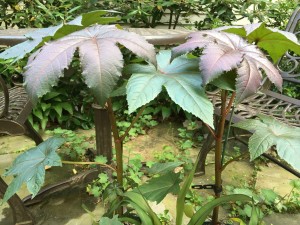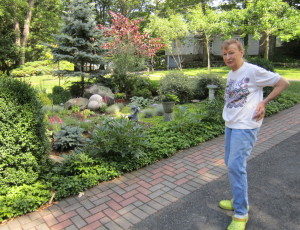Hello, fellow lovers of all things green. Last week, I shared the desperate measure of hacking back leatherleaf viburnums plagued with aphids. Ironically, Betsy from Stone Church, PA, asked about using castor bean plants in her garden, which I planted to camouflage the ‘uglies”of the’leafless sticks while the viburnums recover.
Are castor bean plants dangerously toxic?
Betsy heard castor bean plants are dangerously toxic. It’s true; technically, all parts of the plant are considered poisonous if eaten. However, the seeds contain the highest concentration of ricin and are especially toxic. But then, many of our ornamental plants, such as azaleas, yews, and daffodils, are toxic if ingested. You’d worry about planting many things if you review the list of poisonous plants, including the foliage of food plants such as onions, garlic, tomatoes, lima beans, and potatoes. The bottom line, we should teach our children not to eat what’s not intended to be eaten.
Benefits of castor bean plants in the garden
Castor bean (Ricinus communis) is a tropical plant native to Africa. It is a striking annual plant in our zone (5b or 6). The large reddish leaves are a commanding presence in the garden, and the plant grows 5 to 7 feet or more. It prefers full sun or light shade and can handle most soil other than constant wet feet. However, its fuzzy flowers are not its finest feature, hidden by its unusual foliage.
I cherish the last garden tour I took with my dear mom of Thomas Jefferson’s Monticello estate in Charlottesville, VA, before her final stages of dementia. Jefferson was a collector of plants, and, as the tour guide explained, he left his mark in the history of horticulture ‘as a facilitator and champion of using plants as an agent for social change.’ Meaning – plants can facilitate a livelihood for those who cultivate them and provide food.
Thomas Jefferson cultivated castor bean plants to deter moles.
It’s fascinating to learn about Jefferson’s trials and tribulations. He deliberately planted castor beans in hopes of deterring moles without success, though an oil distilled from the beans and applied to the soil may work. However, as with medicinal castor oil, the poisonous ricin is removed during distilling. Thomas Jefferson cultivated a castor bean plant to grow 22 feet tall, fitting for his competitive nature. Think of all the ‘uglies’ that could hide! Garden Dilemmas? AskMaryStone@gmail.com or your favorite Podcast App.
“Enough is Enough”
I introduced castor bean plants to a beloved client, who became a friend thinking we found a sure win on deer resistance because of toxicity. It turns out the darn deer chopped the plants and spit them out. I joke that Barbara moved to the Carolinas to escape her deer dilemma. She hoped to find the culprit writhing in abdominal pain or worse, preferably dead. I should mention that Barbara is a kind, loving soul. But “Enough is Enough!” As she said those words, I cracked up.
You know, we can say that about a lot of things, can’t we? Enough is Enough. May we all learn to be kind to each other. Accept our differences, our uniquenesses, because, in many ways, we are the same. Wanting to enjoy our lives, take care of our families, and live comfortably and peacefully. That is my wish for all of us.
Link to the story about the leatherleaf viburnums plagued with aphids – Reasons to Prune.
About Thomas Jefferson’s Monticello estate
This column is featured in Episode 29 of the Garden Dilemmas Podcast
Column updated June 6, 2021





I live in zone 3-4 in Minnesota, I love castors especially the Carmencita, which grows about six feet with wonderful reddish leaves and seed pods. It’s a sight to behold when backlit from the sun or at night by my porch light. I also enjoy the regular green with bronzy seed pods as it grows much taller. My husband jokes that it must be the bean stalk Jack planted, it seems to grow some every day, especially in August. I have a twenty year old shade garden in a grove of trees with tons of mature shade plants. We lost a few trees last year and well, now it’s a sun garden. I didn’t have time to move everybody to a new shade area I started sooo good old castors to the rescue. I don’t have to watch my old shade friends struggle in the hot sun. Plus I really enjoy the castors out the window. My mailman says one day, “were these always here?” They had grown so fast!
Hi Linea, Thank you for sharing your story! I can visualize your beautiful garden as I read your words! I appreciate you writing in and reading my column. Here’s to Castor Beans :^), Mary